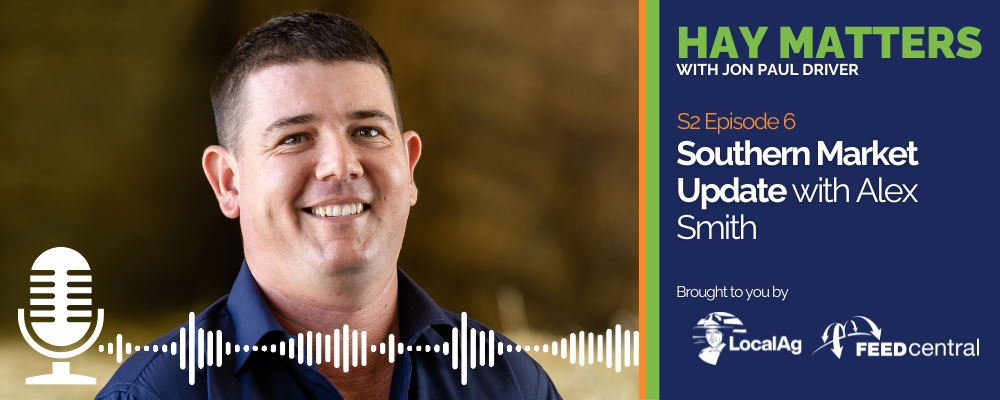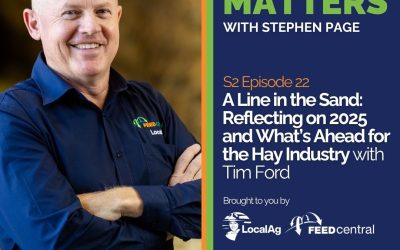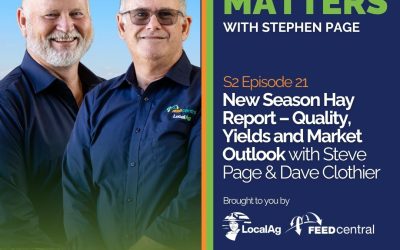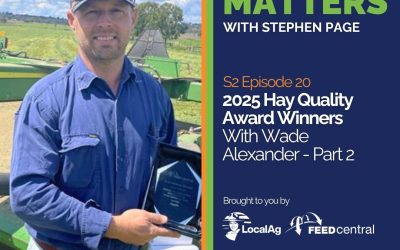
In the latest Hay Matters Podcast brought to you by LocalAg and Feed Central, Key Account Sales Manager Alex Smith shares insights from the ground as he travels across the south-eastern states. With southern regions facing dry conditions and Queensland still dealing with the impacts of flooding and beginning their recovery, Alex discusses the shifting dynamics in feed production, market demand, and the value of forward planning.
Key takeaways from the episode:
- Widespread silage has already been made, with buyers now selectively sourcing high-quality cereal, vetch, and lucerne hay.
- The feed trade has flipped again this year, with hay moving from northern and central regions back down to the south.
- Flooded areas in Queensland are experiencing supply delays, while drought conditions in the south are increasing demand pressure.
- Quality hay is in high demand, with delivered costs climbing as buyers look further afield.
- Recent weather events across much of Queensland and Northern NSW have lifted cattle prices due to limited access and uncertainty around pasture recovery. It may take several months before the full impact is known, which is keeping fodder demand in the north relatively low for now.
Read Transcript
Jon Paul Driver 0:05
Welcome to the Hay Matters podcast brought to you by LocalAg and Feed Central. This is your go to source for all things hay related in Australia. I’m your host, Jon Paul Driver, and in today’s episode, we’re joined by Alex Smith. Alex is the Key Account Manager for LocalAg and Feed Central in Southeast Australia, and we have a market update for you today. Welcome to the podcast, Alex.
Alex Smith 0:28
Thanks very much, JP, it’s been a while between chats, mate, but good to be talking to you again.
Jon Paul Driver 0:33
Yeah, we have some weather to talk about. It’s from one end of the spectrum to the other.
Alex Smith 0:38
It is, mate. Australia is a big country, as you know, and it’s always a place that throws many different variables in. You’ve got the northern parts of Australia through Queensland, Northern Territory, and some parts of northern New South Wales that are experiencing some flooding, you know, some major flooding, through to some minor flooding. And then at the other end of the scale down in sort of Southern Australia, through South Australia, Victoria and southern parts of New South Wales, they’re experiencing very dry and drought conditions at the moment. So one end of the country to the other is completely different.
Jon Paul Driver 1:18
And how does that flow through to the hay markets in those regions, historically speaking?
Alex Smith 1:23
Hay is always made in the south and always heads north this year and probably for large parts of last year. Also, it was roles reversed to a degree. It was hay made in New South Wales and Northern Victoria and South East Queensland, and majority of the hay went south. Well, look, I think, to be fair, the flooding crisis in Queensland at the moment is still unfolding. There’s some helicopter drops of hay happening, and trucks trying to get through to bring livestock some hay that have reached higher points of ground. So that’s still yet to unfold. So we haven’t really seen the impact on the hay market up here yet, definitely in the south, though, with the dry conditions, you know, getting further into autumn without a break, as yet, the demands only increasing in the south, putting a bit of pressure on the hay job. That’s for sure.
Jon Paul Driver 2:13
We’re coming up on planting season, right? We are in my my mental model says Anzac Day is like the start of planting season. Maybe in Queensland, it’s before that.
Alex Smith 2:25
Yeah, so they’ve probably started a few weeks ago. Further north, there’s definitely some people starting to scratch a little bit in down south, you know, sowing dry and hoping for that break. And also, just through my recent trips this week through southwest Victoria and South East South Australia. There’s people also waiting until post Anzac Day and then, and then they’ll plant. So, yeah, definitely starting to hit that time of cropping. You know. Hope a bit of weather comes through for those guys, and they get a bit of rain, and their crops out of the ground.
Jon Paul Driver 2:56
In the south, right, planting dry in the south, and…
Alex Smith 3:00
Planting dry in the south, and then these guys in Queensland, they’re definitely going to take advantage of this moisture in certain spots. I mean, not all of Queensland that is underwater is cropping country, a lot of its pastoral country, which, you know, just run sheep and cattle through that south east corner of Queensland. I think they’ll definitely take advantage of this rain and then be sowing very shortly, I’d imagine.
Jon Paul Driver 3:24
Alright, let’s switch gears a little bit and talk about some market stuff. I’ll just acknowledge that the US has put 10% tariffs on, I hope I’m not a liability to Feed Central and LocalAg at the moment, the US did put 10% tariffs on Australian beef coming to the US. What’s your initial reaction to that?
Alex Smith 3:45
Oh look, to be fair. JP, you know, it’s all sort of happened within the last 24 hours. So I think to formulate an opinion, we’re going to need to see it play out for a little bit of time. Yet, I know a lot of our major companies have been working really hard, forming new partnerships and relationships right across the world. So if one country is having a bit of a tougher time, we’re not super reliant just on that one source of income. We have multiple so look, you know, it’s going to take a bit of time to pan out and see what effects it really has. And I don’t think you’re going to see the full effect of it, you know, for possibly 12 months or so before you get a bit of an idea of what’s actually happened.
Jon Paul Driver 4:31
Nothing drastic. Here’s what I hear. He’s telling me is more of a muted impact because of that diversity in markets.
Alex Smith 4:37
Yep, no, the diversification is key. Look, I think Australia has done really well promoting their beef, sheep, pork, whatever it may be, right the way across the globe, to make them not reliant on one particular country.
Jon Paul Driver 4:53
Is there anything else than livestock markets that we should be watching?
Alex Smith 4:57
In the short term? It’s still raining in Queensland. And this week we’ve had four or five sales, cattle sales, that is and sheep sales down in New South Wales, Victoria, and they have been considerably dearer now, whether that is just processes and feed lots wanting to secure cattle or sheep, because they’re not sure if they’re going to get them out of Queensland and Northern Territory over the next little while. So we’ve definitely seen a short term spike. And unfortunately, for some in Queensland, there is talk of major stock losses that will probably have a flow on effect, I’d imagine as you get further into the season.
Jon Paul Driver 5:37
So temporary, just movement disruption, then we’ll have to wait to see what the longer term impact of the flooding is.
Alex Smith 5:44
Yeah, look, we’ve, definitely seen a little bit of an uptake temporarily in in cattle and sheep prices, just because, you know, a lot of their areas that they they pull a lot of cattle and sheep out of they can’t access yet to see the long term effects. I guess once the flooding clears and and we can assess the damage up there.
Jon Paul Driver 6:03
Let’s talk prices really quick on the various types of hay. Are we seeing stability? Are we seeing increases decreases? What’s that look like now? And for the coming weeks?
Alex Smith 6:15
Look, I think we’ve seen an increase in demand. Quality hay is also, you know, as always, it’s always key. But look, I think we haven’t seen too much of a price rise, but we’ve seen buyers definitely shift their focus to that FCA grade, whether it be a cereal, lucerne and vetch, they’re definitely turning their head towards quality as they enter into the autumn, winter months, and those, whatever they’re feeding, needs that little bit more punch because of the colder weather. So look, I mean, it’s the same story as always. I’m not sure how much a hay market is going to change just because of, you know, people’s finances and budgets and, you know, they’ve been feeding for so long. Unfortunately, what will change is the quality hay is only going to get further and further away from where that purchaser is going to be. So your delivered price inevitably becomes higher. I mean, at the moment, we have loosened trading somewhere between 400 and 450 some cereal hays, but 300 to 350 a tonne. I think there’s money in that for the sellers. But also, you know, it’s not a super dear, you know, ridiculous price that, you know, buyers can’t afford also, so I think it seems to be a fairly good, mid, middling ground at the moment. But as I said, it is key to probably get in and make your purchases early before it gets further away and freight becomes a bigger cost.
Jon Paul Driver 7:41
Good takeaways. Anything else to add?
Alex Smith 7:44
As tough as it is across the country right now with either flooding or drought, the Aussie model of resilience is is still key. Like I’ve spent, I can’t talk for the guys in the north, but I’ve spent the last week on the road through the South, and it blows me away how optimistic they all are, you know, considering they’re facing some challenges at the moment, and I just think that agriculture is becoming smarter. And look, they’re just putting one foot in front of the other and diversifying their business and looking for new opportunities, which I think, you know, is only going to grow the industry, going forward.
Jon Paul Driver 8:23
With that, I’ll say thank you very much Alex for joining us.
Alex Smith 8:26
Thank you. JP, it’s been a pleasure to chat as always, mate.
Jon Paul Driver 8:29
Alex works for Feed Central and LocalAg, out of southeast Australia, and if you’re interested in listing products and you’re in that neck of the woods, you’ll probably end up working with Alex. Thank you for your insights today and look forward to having you back again in the future. This podcast is proudly presented by Feed Central and LocalAg, stay tuned for upcoming episodes.
Transcribed by https://otter.ai



